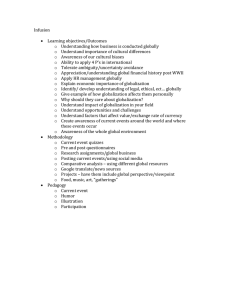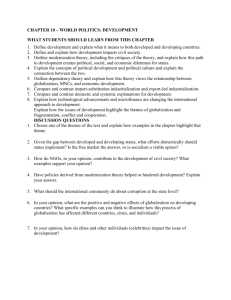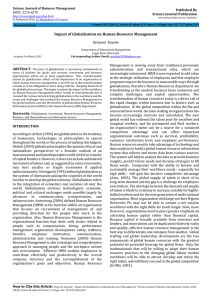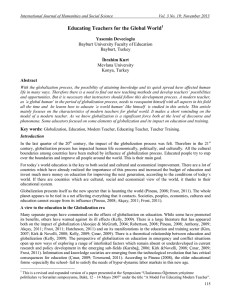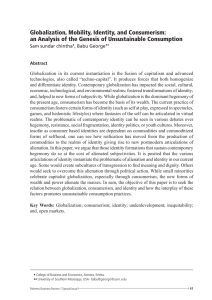Children, Youth, and Globalization
advertisement
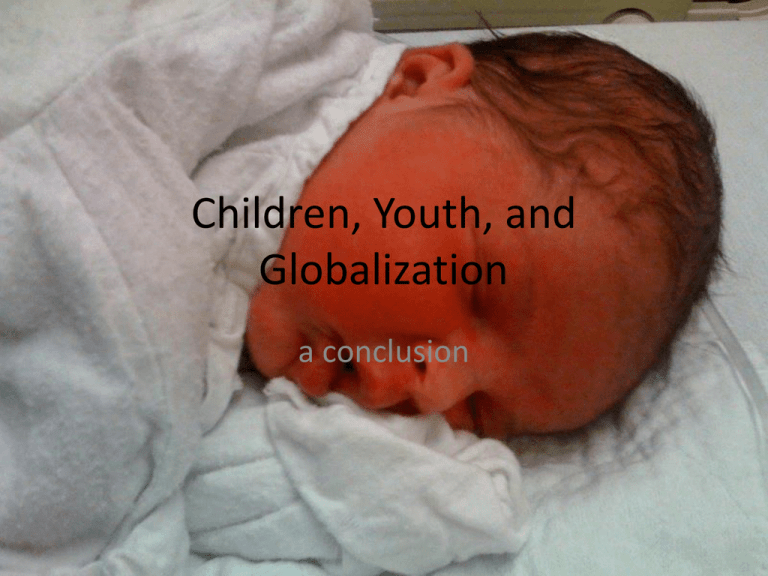
Children, Youth, and Globalization a conclusion Where we began • An interest in contemporary children’s culture • An understanding that cc is affected by globalization • An interest in voice and agency in children’s lives • A curiosity regarding what the UNCRC is and how its connected to all of this • A desire to understand the relationship between institutions and individuals, adults and children, and the local and the global We built a tool box with critical theory Ideologies Social Construction Social Variables Binaries Power versus Powerless Adult/Child Binary Empowerment Consumerism and Commodity Culture Globalization Universalization Concrete Images/Abstract Ideas Politics of Childhood Child as Political Tool Children’s Own Culture Adult Agenda Agency/Self-Determination Adult Allies We began to explore the “undefinable” globalization “The movement, interaction, sharing, co-option, and even imposition of economic goods and services, cultures, ideas, ideologies, people’s lives and lived experiences, food, plants, animals, labour, learning, play, practices, and knowledge(s) across time and space(s) previously thought to be impossible or at the very least improbable.” (Gennaro, 2010) BUT: • • • • ITS NOT A-HISTORICAL IT IS NOT STATIC IT IS NOT FINITE IT IS NOT INNOCENT We actively seeked out the 3 voices of CCC 1. institutional (about children) 2. Institutional (for children) 3. Children’s voices • In theory, in practise, and in story And explored a range of contemporary issues in children’s global lives • • • • • • • Child labour Child soldiers Children and HIV/AIDs Children and popular culture Children and war Children and consumerism Children and technology And most importantly, we tried to flip the map We examined the writing of history, the power of imperialism, the notion of voice and the subaltern and the importance of context And asked What if we flipped the map to see CHILDREN AS: HEROES IN HISTORY (Davis, 2010) CITIZENS IN THEORY & ACTION (O’Neil, 2010) WRITERS OF THIER OWN EXPERIENCE (Buckingham, 2010) But how did we do this? Thinking about the concept of “youth” PTCTI • The saturated self • Imagined community of youth • Synergy and convergence Thinking globally about culture • • • • Globalization as hybridization The 5 scapes Evil Bertladen and whats lost in translation Globalization as more than just Americanization • The need to connect the local with the global Thinking about the construction of culture/power HISTORY: • Its about story telling– but who’s stories are being told? THEORY: • Is about understanding the dynamics and relations of power in society » ADULT vs CHILD » POWER vs POWERLESS » REPRESENTATION vs REALITY » FASLE GENEROSITY vs ADULT ALLIES WRITING: • Is about naming the word and naming the world. • The power of language Thinking about context • But what about bias? • What about cultural relativity and sensitivity? • There is a need to not only think globally and act locally but to think locally and act globally But more than theory was needed: • We needed to explore what institutions like the UN and UNICEF had to say about it. • We needed to explore how these ideas were explained to children • We needed to explore children’s own voice. • Now the big question remains: • What are you going to do about it?
